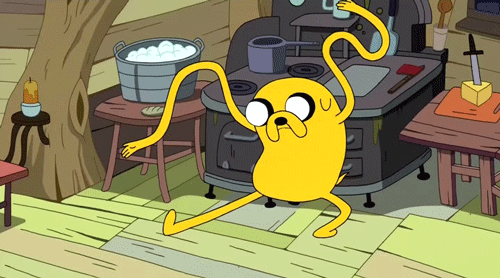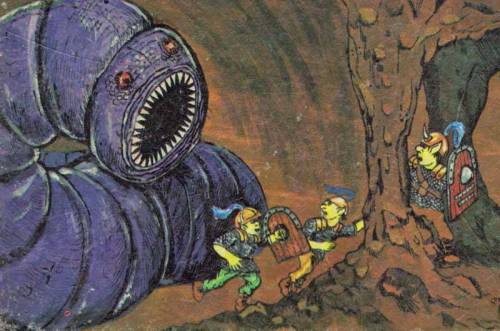- The Lost Mines of Phandelver (5th edition D&D for middle school players)
- Olde School Wizardry (all-wizard homebrew for adults)
- Hoard of the Dragon Queen (modified to B/X D&D for grade school players)
First up, in our 5th edition Lost Mines campaign, the five players decided to postpone following any of the "quests" that the adventure writer had dangled via the various residents of the frontier town of Phandalin (in particular the recent bounty offered on orcs) and instead focus entirely on defeating the Redbrand briggand gang. With the party composed of a wizard, a couple thieves, a cleric and their pet goblin, they knew that a straight showdown would be out of the question. But what was the best way to open a guerilla conflict with the gang who had them both outnumbered and outgunned?
By hiding a goblin down the privy of course!
Though a series of comic gaffs followed, resulting in a terrified barkeep with a strong suspicion that his outhouse was haunted and a barmaid with a concussion, the party eventually got their man and hauled the hog-tied briggand back to the storeroom of the Stonehill Inn for interrogation. We ran out of time there, but several of the players voiced their opinion that this had been their very best session to-date.
Next, in Olde School Wizardry, the trio of student wizards, trapped in a cavern with a reanimated skeletal dragon, managed to use much of the magical oil that they were sent to recover to allow one wizard (T. Table) to channel his casting through the addled brain of Hydromancer Pronk, one of his peers. Unlike the other wizards, Table knew the Ancient Rune of Restoration, but since a series of nasty traps had dissolved all the bones in his arm, he wasn't personally capable of working any magic at all!
Meanwhile, making good use of his time, Pronk had carefully studied the notes left behind by the deceased Brothers Vile, whose former hideout this was, allowing him to learn the rudiments of Bone Science.
Though all three wizards lacked the proper magical formula to employ the Restore Rune specifically to replace the missing parts of living creatures, the lads decided to give it the old college try anyway in an effort to get Table's arm (and spellcasting ability) back. Tense hilarity followed as various properties of all the Bone in the target area of their spells were magically Restored. In one particular horrible casting, Table's pelvis was Restored to the same size it had been at the time of his birth! Eventually, however, Table both survived the process and regained the use of his arm.

With Table back in the game, his knowledge of Stone Science allowed the wizards to gradually scoop free the rock holding the dragon trapped in place, releasing into their campaign that world's very first dracolich, and she agreed to let the wizards depart unharmed (and even made an effort to recruit them to help recover her long lost hoard).
Finally free, and the Arch Chancellor's missing robe in hand (the object of their quest), the trio headed back to the Collegium Mysterium, along the way tangling with some slavers, transporting a pair of mmung (transdimensional, vegetable cyclops-things), and magically augmenting the wood of their captured boat to speed them upriver.
 Finally, in our Homeguard campaign, three fighters and a cleric, having escaped The Cult of the Dragon via The Great Escape scenario from Castle Caldwell and Beyond (B9) and navigated wilderness encounters with both pixies and a cockatrice, made their way to the border village of Greenest ... only to find it under attack by the cult's forces!
Finally, in our Homeguard campaign, three fighters and a cleric, having escaped The Cult of the Dragon via The Great Escape scenario from Castle Caldwell and Beyond (B9) and navigated wilderness encounters with both pixies and a cockatrice, made their way to the border village of Greenest ... only to find it under attack by the cult's forces!
Rather than seeking refuge in the keep with the townsfolk, as the writers of the adventure had assumed, the party stuck to the hills around the community. From hiding they made a count of their enemies and, perceiving that they were badly outnumbered, settled upon a plan to free the various drakes used by cultists to sow chaos among the ranks of their foes.
 Dressed in the gear of the cultists, they staged a series of strikes to disrupt the besiegers. Though the freed drakes never rampaged as they had hoped, the party still managed to use surprise to their advantage and began driving a wedge between the human troops and their kobold allies.
Dressed in the gear of the cultists, they staged a series of strikes to disrupt the besiegers. Though the freed drakes never rampaged as they had hoped, the party still managed to use surprise to their advantage and began driving a wedge between the human troops and their kobold allies.
So ... apart from the obvious ... (being completely awesome) ... all three of these sessions had a common theme running through them -- player agency. Even when experienced, well-meaning professional game writers laid down a broad, well-scripted track, these three separate groups of players just weren't having it! They had ideas all their own and were determined to crack open the challenges that I "set the table with" without any regard for the broadest or most obvious solutions.
As you've probably guessed ... I LOVE that kind of action -- it empowers the players, adding to their satisfaction, and creates as much excitement and anticipation for me as the GM as the players feel when the game is at its very best -- I don't know what will happen next any more than they do and so I get to experience the unfolding of an epic (or disastrous) story in real-time right along with them.
So if a session brimming with player agency is the creative and emotional sweet spot of tabletop role-playing, what can a GM do to get as many of his or her games there as possible?
I don't know for certain, but here are a few initial thoughts:
- pack light -- if I generate stats for an NPC, the group will by-pass that NPC 9 times out of 10. If I laboriously stock a multi-level dungeon, they'll spend exactly five minutes there before remembering something else they are more motivated to do. In response, I've got to focus my pre-game prep-time on thinking more broadly about the campaign world.
- random charts win -- magical effects, creatures encountered, rumors ... a handful of charts tailored to my campaign world can give me more mileage than any 60-page supplement.
- sketch out the problems -- leave the solutions to the players. If I don't try to anticipate how they'll solve the problems I toss out there then I'm much less likely to try and script their behavior.
- real consequences -- for every problem I introduce, I need to know in advance what will happen if the players decide to walk away and not accept the challenge. After all, if there are no consequences then the players don't really have any agency at all. This is one area where my cherished "classic TSR era" adventure modules almost always let me down ... they never provide much guidance of what happens if the characters don't ride out to rescue the princess, at most making some petulant jabs about them not being real adventurers if they don't happen to want to play along.
- balance is for chumps -- if the challenges that I throw out match the ability level of the characters ... well then that really just encourages the players to take the most direct approach (which often boils down to combat). That's just rock-paper-scissors with 20-sided dice, isn't it? On the other hand, if my level-one noobs have to deal with ogres and owlbears ... well then they have to think asymmetrically, chicken out, or die like lemmings.

How much better would The Keep on the Borderlands be if the "Caves of Chaos" contained a 15 Hit Dice purple worm? Can you imagine all the goblins going quiet and scattering from combat when "the great one" started to surface? How would players learn to adjust their tactics and thinking to use such an unstoppable opponent to their advantage?

No comments:
Post a Comment